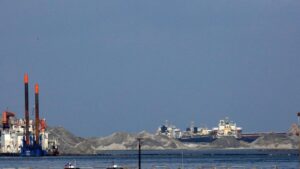📷: Mario Alvaro Limos | Esquire
By Diego Morra
By its actions, the Marcos Jr. administration cannot prevent floods from swamping Metro Manila and stop Hagonoy and Calumpit towns in Bulacan, as well as Ramon Ang’s fiefdom in Bulakan, Bulacan, from being perpetually inundated. The proof is the latest reclamation deal won by the NMDC Group of the United Arab Emirates (UAE) to undertake another reclamation project in Manila Bay.
A story written by Nivetha Dayanand and carried by Gulf News on October 2, 2025 reported that NMDC, which used to be known as National Marine Dredging Co., won a $610.1-million reclamation project to create a 130-hectare “eco-friendly” waterfront area in Pasay City. The contract was signed between NMDC and the Pasay Harbor City Corp. (PHCC), a private corporation that collaborated with the Pasay City government to reclaim up to 265 hectares of Manila Bay under a so-called Public-Private Partnership (PPP). PHCC secured a P57-billion loan from five Philippine banks on June 28, 2022, to finance the venture proposed by brothers Carlos S. Gonzales and Manuel S. Gonzales, whose construction company is based in Davao City.
Strangely, the PHCC-NMDC deal came three years after PHCC reported that it had already reclaimed 117 hectares through the work of the Netherlands-based Royal Boskalis Westminster N. V., one of the world’s leading dredging companies after the Belgium-based Baggerwerken Decloedt En Zoon (BDC.) PHCC reported that the work on the waterfront city would be concluded in 2028, including roads, bridges, drainage, water, power, sewerage, communications and other primary utilities and facilities. It is not known whether this is the same project that the Marcos Jr. administration ordered stopped when it took power on June 30, 2022, barely two days after PHCC announced the P57-billion loan agreement. Presidential Legal Counsel Juan Ponce Enrile also disclosed that one reclamation project proponent pleaded with Malacanang to allow their venture to proceed after the President sought to freeze all such projects in Manila Bay.
“By entering the dynamic Philippines market, NMDC Group continues to expand its operational presence in Southeast Asia as part of its strategic push towards diversified, global growth,” said Eng. Yasser Zaghloul, Group CEO of NMDC Group. The deal is part of a vigorous push by the company to expand its presence in Asia following its expanded operations in Taiwan, Vietnam, India, and Malaysia. The Manila Bay contract is NMDC’s first in the Philippines, which has been battered by frequent flooding, worsened in part by the unrestrained reclamation projects in Manila that have blocked existing waterways that drain into the bay, exacerbating the deterioration of water quality and water exchange, preventing the discharge of contaminants into the sea, and lengthening the period for floodwaters to recede.
Manila Bay has a surface area between 1,994 and 2,000 sq kms (around 770 sq miles), with a water volume ranging from 28.9 to 31 billion cubic meters (28.9 to 31 km³) and an average depth of only 17 meters. The shoreline length is about 200 km. The entrance to the bay is narrow at 19 km (11.8 miles) wide. No less than 10,000 hectares of Manila Bay will be reclaimed, with the projects along Roxas Boulevard estimated to eat up 6,100 hectares, the combined territory of the cities of Manila and Marikina. Curiously, the reason advanced to reclaim more land from the bay is that Metro Manila has “limited land” for development, not for mass housing or industrial sites, but for business purposes that benefit large corporations operating casinos and commercial centers.
The NMDC reclamation project should raise furious reactions from the people of towns of Hagonoy, Calumpit, and Bulakan in Bulacan, as well as condemnation from Pampanga towns that continue to be inundated due to substandard flood control projects. Residents of Hagonoy and Calumpit have actually mounted protests and demanded that the national government finally act to prevent their towns from becoming lakes. Wags have said that “Langoy, Hagonoy” and “Kapit, Calumpit” are not exactly endearing slogans, but they illustrate Malacanang’s lack of concern for their welfare, are they continue to be flooded at high tide. The situation worsened when reclamation projects sprouted like mushrooms in Manila Bay, with the Duterte administration allowing these projects willy-nilly, without as much as asking citizens whether they approve of them or not.
Stealing 10,000 hectares from the sea means reducing the volume of water that Manila Bay can carry, thus guaranteeing floods ion Metro Manila, while allowing at least five seabed quarrying operations in several Cavite towns are a surefire method to destroy the marine environment and force schools of fish to migrate to deeper sections of the bay. Despite his earlier promise to assess the impact of reckless reclamation projects, many of which were authorized by the administration of Rodrigo Duterte (one very close Duterte aide reportedly lawyered for some companies that practically divided the bay among themselves), President Ferdinand R. Marcos Jr. has not come out with an assessment of the 25 reclamation projects in Manila Bay.
A study conducted in 2023 by Charina Repollo and 47 other experts from the Marine Environment and Resources Foundation Inc. (MERF) for the Department of Environment and Natural Resources (DENR) warned the most fundamental impact of the reclamation projects is the change in the natural flow of water currents in the bay, causing contaminants to “likely stay within reclamation sites.” Risks from exposure to pathogens and toxic substances heighten during extreme weather, she noted, citing the “extremely high” sediment build-up and total suspended matter (TSM), or undissolved particles, which are pollutants, during Supertyphoon “Carina” in July 2024. Repollo, the deputy director for research at the University of the Philippines Marine Science Institute (UP-MSI), said “reclamation significantly disrupts the natural circulation of water in Manila Bay.” She added that “the construction of large coastal structures and alteration to the coastline weakens water exchange, resulting in stagnation and the buildup of sediments, pollutants, and debris in specific areas.”




